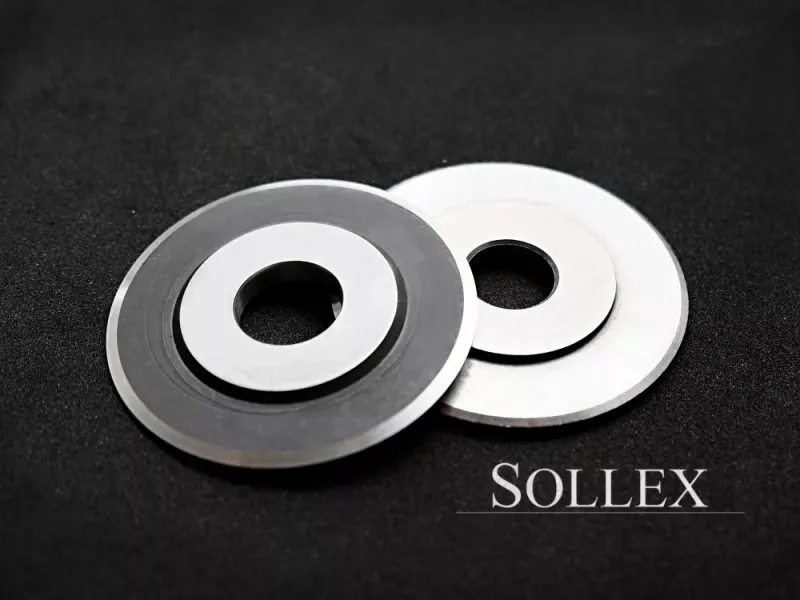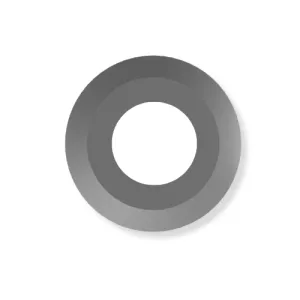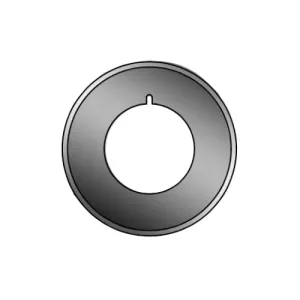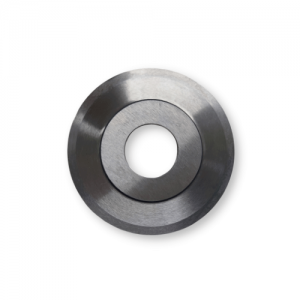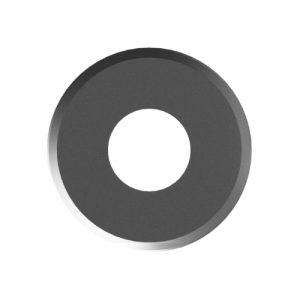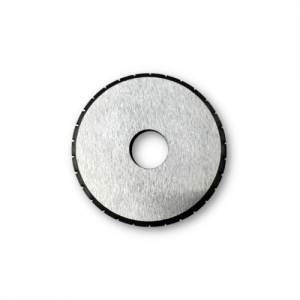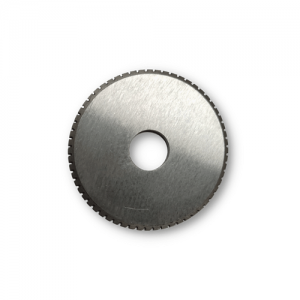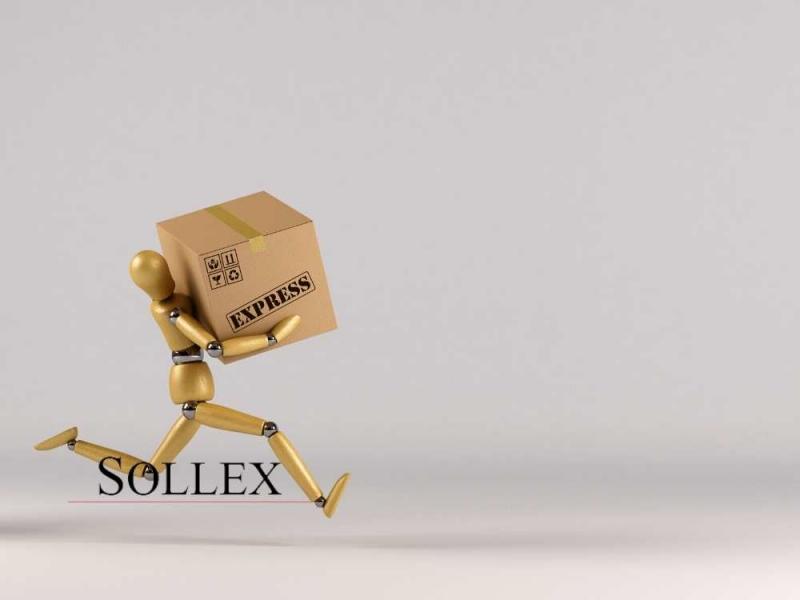About Crush Cutting & Crush Cut Knives
Content:
- About crush / score cut slitting method
- Crush cutting application
- Difference between crush or score cutting
- About crush cutter knives and score blades
- Crush cut knives with radiused cutting edge
- Knife holders for crush cut knives
About Crush / Score Cut Slitting Method
Crush or score cutting is one of the three slitting methods, along with razor blade slitting and shear cutting, for converting flexible materials.

The web material is cut in the slitter machine by pushing a loaded crush cut rotary knife with a "blunt" radiused cutting edge, mounted in a pneumatic knife holder, against a hardened metal anvil on which the web of material is placed.
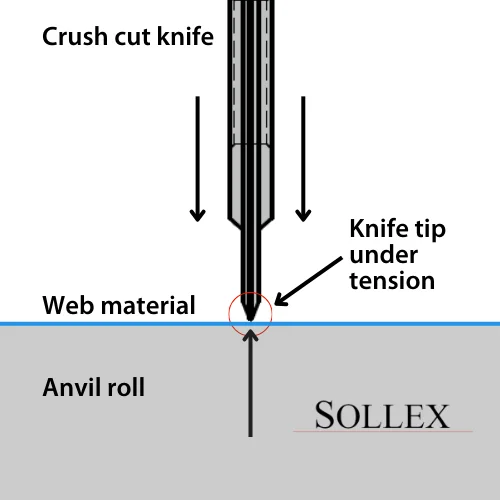
When crush cutting either tangential or wrap web paths can be used.
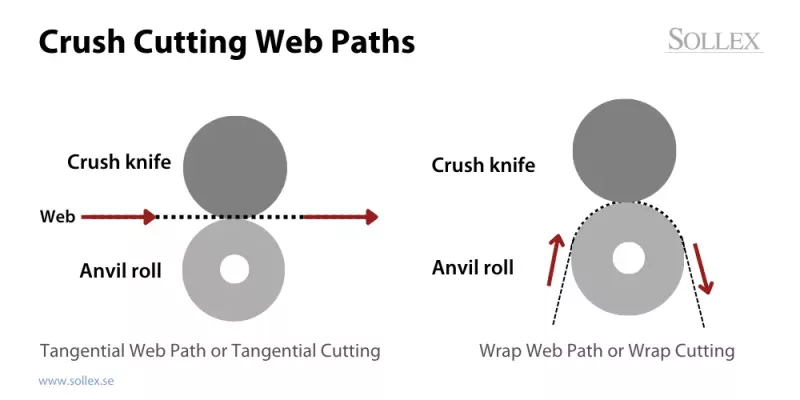
The crush slitting method gives the worst edge quality and is less accurate than other slitting methods (shear cutting or razor blade slitting).
Furthermore, crush slitting will generate more dust while separating the material. However, there are cases where this method has advantages, e.g. when the speed of installation is more important than the quality of the cut edge or when the material is too abrasive to be cut with shear slitting circular knives or slitting razor blades.
Razor Slitting | Crush Cutting | Shear Slitting | |
|---|---|---|---|
Advantage | inexpensive | easy to set up | high accuracy |
Disadvantage | limited application | generates dust | expensive |
Width tolerance | ±0.50mm | ±0.75mm | ±0.15mm |
Slit width | 12.50mm | 12.50mm | 12.50mm |
Application | films, vinyls, foils | rubber, tissue, paper, adhesives, laminates, non-wovens | heavy films, foils, paper, cardboard |
Crush Cutting Application
The crush cutting method has its limitations and can be used in converting certain materials, mostly rigid materials such as rubber or abrasive materials such as sandpaper. But sometimes foil, laminates, labels, adhesive tapes, labelstock, nonwovens, tissue and paper can also be crush slit.
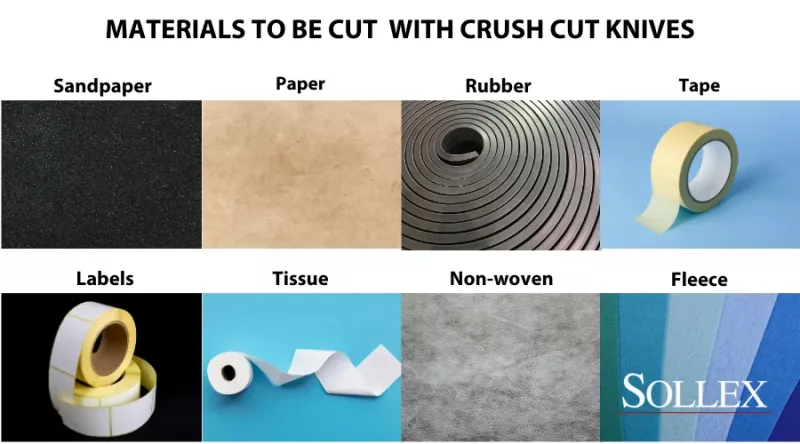
Materials to be converted by crush cutting:
- paper, paper with adhesives
- sandpaper and abrasive paper
- fleece, nonwoven materials, tissue
- PVC, PE, PP
- adhesive tapes and labels
- vulcanized and unvulcanized rubber production and rubber processing
Difference Between Crush or Score Cutting
When defining the crush cutting method, the words " crushing" and " scoring" are used synonymously, although technically there is a difference between the two. In crushing, the wide web is split into two separate narrow webs or, in the case of using crush cut perf knife, the perforated pattern is punched through. When score cutting a multi-layer material, the material is partially cut, leaving at least one layer intact, or a line is pressed through the web that allows the material to be easily bent, such as in the production of cardboard boxes.
About Crush Cutter Knives & Score Blades
Crush cut knives are machine knives used in crush or score cutting. These industrial knives are also referred to as Crushing knife, Perforating knife, Crush cut perf knife, Score / crush cutter, Score cut knives, Circular Crush / Score knife.
The crush cutting uses a steel circular knife and an anvil roller, both hardened. The knife is not only ground after hardening, but the cutting edge is radiused and then polished.
The key to production efficiency and quality of cut material is to select the correct crush cut blade radius and cutting angle. Crushing knives with an angle of 45 degrees (there are 3 alternatives: 30°, 45°, 60°) are considered universal. You will then be able to confirm, on the basis of practical experience, which particular blade radius and angle is the best to consider in your case. If the crush cutter life is too short, a larger radius or angle may be considered. Crush cutters are available in D2, HSS-M2. We manufacture and supply both standard and custom crush cut knives and blades for most applications.
The universal crush knife has a bevel angle of 45° and an edge radius of 0.10 - 0.15mm.
Angle, ° | Radius, mm | Application |
|---|---|---|
30° | 0.05 - 0.10mm | Cellophane, adhesive tape, linoleum |
30° | 0.15 - 0.20mm | Rubber, paper backed foil, laminates, pulp |
45° | 0.15 - 0.20mm | Tissue, paper, masking tape, laminated paper |
45° | 0.25 - 0.30mm | Waxed paper |
60° | 0.15 - 0.20mm | Nonwovens |
60° | 0.25 - 0.30mm | Abrasive material, sandpaper |
The shape of the cutting knife edge is usually circular, straight, but can also be zigzag and wavy.
Outer diameter | 50–140 mm |
Inner diameter | 19–65 mm |
Thickness | 2.5–5.0 mm |
Standard cutting angle | 30°, 45°, 60° |
Edge radius | 0.05 - 0.30mm |
Materials | D2, HSS-M2 |
The service life of a crush cutter blade depends on the radius and angle of the tip, since these two determine the tension centered at the tip of the blade. All score and crush cutting knives should have a small radius at the tip, rather than a pointed tip that will snap as it rotates against a hardened shaft. The quality of the cut is again defined by the radius and angle of the blade tip. Smaller radius will produce less dust with a cleaner cut, but will result in shorter knife life.
The anvil roll needs to be much harder than the knives, otherwise strong grooves will be formed. Typically, a 64C Rockwell hardness is considered the minimum. This implies that the hardness of the crush cutter blades should be about 4-6 points lower.
Crush Cut Knives with Radiused Cutting Edge

As the crush cutting requires brute force from a pneumatic knife holder to push the circular knife blade through the material towards the hardened anvil roll, the blade radius and the choice of cutting angle play a significant role in the efficiency and quality of the cut in crush cutting. It follows that the rotating knife cannot be razor sharp, as the very fine edge of the cutter knife will become dull and chip almost immediately on contact with the surface against which it is crushed. Consequently, a crush cut knife used for longitudinal slitting should be radiuses and blunt. Additionally, in order to achieve the best results, the material web, the anvil roll and the slitter knife should move at the same speed.
Knife Holders for Crush Cut Knives
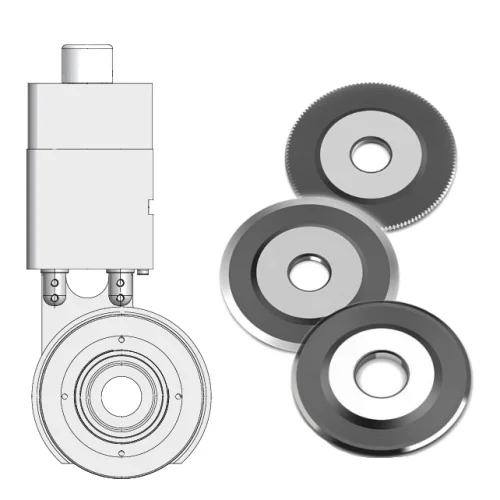
As mentioned above, in slitter machines the knives is held in place by a pneumatic knife holders placed on a shaft and activated by air pressure to press the crush knives into the material and separate the material web to a certain web width.
The design of the cutting knife holder can have different characteristics, the basic ones can be the following:
- minimum slitting width and positioning accuracy
- vertical knife stroke
- non- & adjustable stroke
- knife diameter
- pressure vertical
- holder mounting
- cutting speed in m/min
- air-pressure, bar
- hand protection
The main performance features of the knife holder for crush cutting are the guarantee of maximum stability even at high cutting speeds and vibration damping. Additional features to consider: vertical force, slitting edge quality, micro-depth adjustment, positioning accuracy, high cutting force.
Sollex is a Swedish supplier of industrial knives and machine blades! We have cutting products with cutting-edge technology and performance that improve manufacturing and converting processes and solve problems. With the right knives and blades you can get simplified maintenance, time savings and an improved end product.
You are welcome to contact us with your questions:
Company name: Sollex AB
Customer service and orders: order@sollex.se
Telephone: +4635–15 75 00
Address: Box 5161, 200 71, Malmö, Sweden

